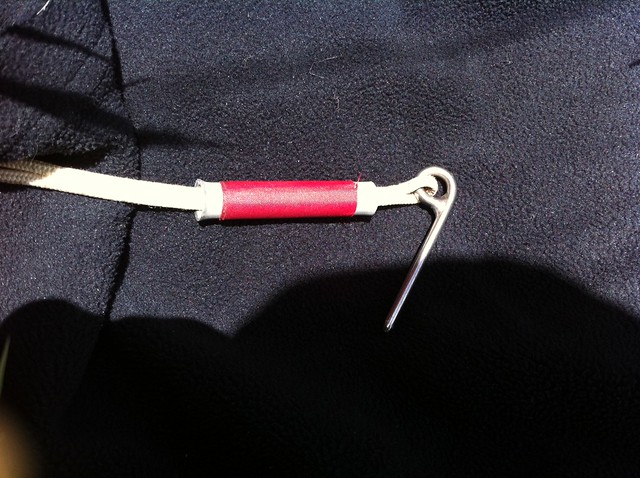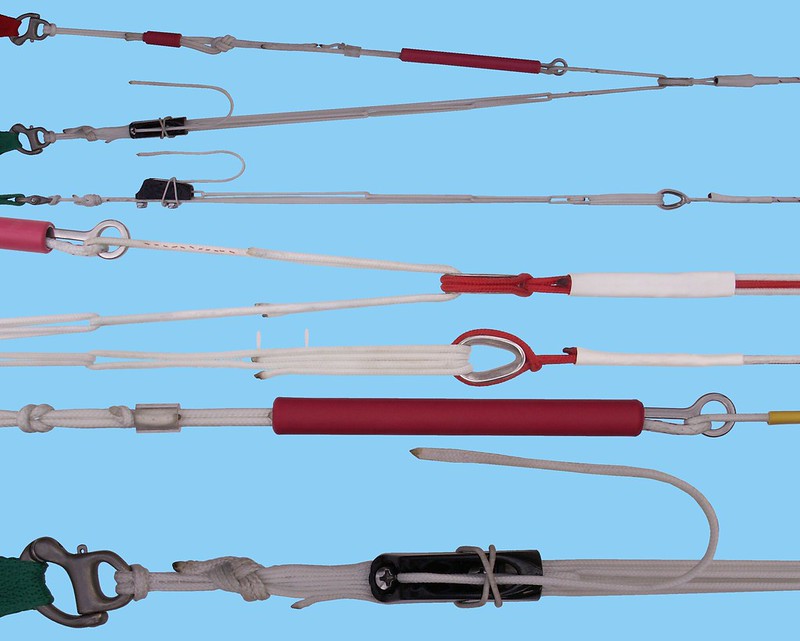http://www.flickr.com/photos/psucvollibre/6634370899/



Perhaps it is thought and made to connect the eye of the V-bridle directly to the release but surely it is also thought and made like this to avoid the mistake of a lateral rotate of the pin when set up.The pin shaft comes off the eye tangentially rather than perpendicularly. (..) It allows more of an offset between the leechline body and the weak link
The nautical definition of a bridle is:Perhaps it is made to connect the eye of the V-bridle...
That's totally consistent with our aeroNAUTICAL employment of the device.a length of rope, chain, or cable fastened at both ends to an object that is to be secured or moved or to a vessel that is to do the towing, a pull being exerted at the center of its length.
- That would be an EXTREMELY bad idea. I one hundred percent guarantee you that nobody stupid enough to use a release like this is smart enough to use a short, fat, wrap-proof one point bridle with a weak link on the other end at the other release (or Bridle Link) and, if one has any brains, one NEVER employs a release which isn't weak link protected at all times no matter what....directly to the release...

- This is a totally imaginary, fictional mistake. Nobody's ever actually made it when hooking up to a tug....but surely it is also made like this to avoid the mistake of a lateral rotate of the pin when set up...
Tell them to keep the shadows of their heads out of the photos in the future.I have got my spies at Forbes and asked for report on every atypical system of release...
This event is being controlled by Davis and the usual flock of other assholes. I do hope they'll have opportunities to get a few flights in as well. (Tell them to double up their weak links when nobody's looking and bribe the launch monitors. That'll help.)...and AT incident/accident.
What is/are the reason(s) for doing this?...you limit the allowable aft travel of the barrel.
Ok you lost me there. Thought Dennis was saying "A weak link is the focal point of a safe towing system."...which is a very common Flight Park Mafia practice, heavily endorsed by Dennis Pagen and Bill Bryden in their excellent book, Towing Aloft.
I re-read your thread "Towing Aloft". I'm still not clear about "it also ENcourages idiots to fly without weak link protection"....configure them in violation of USHGA towing regulations so they don't work when you actually need them to.
http://www.flickr.com/photos/aerotowrelease/8305308635/What is/are the reason(s) for doing this?







In the 1997/02 issue of the magazine I've got a letter to the editor published which says, amongst a couple of other fairly obvious issues, that if you only have a weak link on one end of a long bridle and that end of the bridle wraps at the tow ring (after a release or weak link failure) you no longer have a weak link in your system. So you need weak links above and below or on both sides of a tow ring on any bridle long enough to wrap (and if it's a two point bridle the weak link at the bottom has gotta be stronger than the one at the top).Ok you lost me there...
depicting a Dragonfly bridle/release system with the:Figure 7-16: Fixed Wing Tug Bridle and Release System
But meanwhile, back in the REAL world, a bit of which they advertently include on Page 349:Bridle slips through towline loop when released.
we see that - especially when the shit hits the fan - the fucking bridle tends NOT to slip through the towline loop when released. Which is why the fucking regulations say to put the fucking weak link on the end of the fucking towline and why I've been saying that if you don't put a fucking weak link on the end of the fucking towline then have fucking weak links on BOTH ends of the fucking BRIDLE so there's no possibility of a 250 foot length of two thousand pound spectra becoming your fucking weak link.I witnessed a tug pilot descend low over trees. His towline hit the trees and caught. His weak link broke but the bridle whipped around the towline and held it fast. The pilot was saved by the fact that the towline broke!
Yeah Daniel, I said something like that - in English which would've gotten me through third grade and without the crap about catching on the release mechanism, getting out of position, and finding Baileys - seven and a half years before but nobody listened.Daniel Broxterman - 2005/08/26 14:28:42 UTC
While we're on this topic...at Wallaby in April the launch crew put a 2nd weak link in my system between the bridle and the Bailey. I fly with a two point, Wallaby-style release, with a single Bailey secondary. As I recall, here's the scenario they had in mind:
Pilot releases with primary, bridle catches on the tow line or release mechanism. If pilot becomes extremely out of position, the additional weak link would probably breaks prior to pilot finding and Bailey.
Does anyone else use two weak links, one on each release point?
I wanted to go as small and light as possible, had my eye on a Bimba 1 1/16 inch diameter cylinder with a one inch stroke, and wanted to know why two to three was being recommended. Could find no one who could tell me so when I finally crossed paths with Dennis I asked him. No freakin' clue. It was obviously just something somebody had told him so he just scribbled it down and published it. (I understand hydraulic cylinders now, by the way, and a one inch stroke is just fine.)The small, cheap cylinders manufactured by Boston Gear, Flair Line, Bimba, Humphries and other manufacturers work well. Diameters between 1 1/8 and 2 inches and strokes between 2 and 3 inches are appropriate.
http://www.hanggliding.org/viewtopic.php?t=21033Jim Rooney - 2008/02/13 09:06:35 UTC
Oh..... in failing to answer my "what advantage does a straight pin have" question... you attempt to reverse it to "what advantage does a curved pin have".
Well, two things....
One... no one's trying to improve on your design. The bar was set with the Bailey... it is to YOU to "improve", which you have not done.
Bart Weghorst - 2011/02/25 19:06:26 UTC
I've had it once where the pin had bent inside the barrel from excessive tow force. My weaklink was still intact. The tug pilot's weaklink broke so I had the rope. I had to use two hands to get the pin out of the barrel.
No stress because I was high.
Two... The advantage of a curved pin... it can handle differing thicknesses of materials. Yours can't. You have a very narrow range and then you run into the problem of that pesky stop. That's why yours have weaklinks on both ends... nice and thin.
Call it insignificant if you will, but YOU are the one that is the incumbent... the onus is on you, not Bobby.
And no response.Tad Eareckson - 2008/02/24 19:31:25 UTC
With respect to your assertion that my straight pin barrels can't handle differing material thicknesses...
I closed my personal copy over a loop of 3/8 inch Yale Crystalyne (11500 pounds) and it worked fine. Exactly what are you trying to tow with yours?
And, no, I don't have weak links on both ends - I don't use weak links as you define them. But, in any case, what's your point? Why wouldn't anyone who had done the walnut thing want the redundancy and why would anyone want to increase the material diameter and thus the side loading on either a curved or straight pin release?
Jim Rooney - 2011/08/26 17:34:33 UTC
Try fitting a straight pin release with anything but weaklink. (it doesn't quite fit the same) OH! Right. Just might be that we've thought of that eh?
And no response.Zack C - 2011/08/31 02:45:17 UTC
Why would you want to? Shouldn't releases be protected by weak links anyway?
Not at all, I love to read and learn stuff. Thank you for taking the time to Thoroughly address my questions.Sorry. Way too long an answer.
question, I thought it was Antoine who had asked it. No harm done except:What is/are the reason(s) for doing this?
doesn't make much sense. Substitute "Antoine has" for "you have" and we're back on the rails....as you have illustrated here...